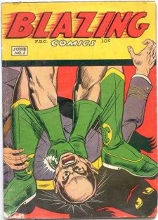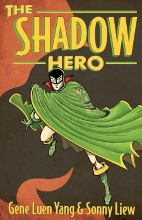 Gene Luen Yang has had huge success with his previous work. His American Born Chinese has a jaw-dropping 350,000 copies in print, and the more recent Boxers & Saints was also a hit, as are his Avatar: the Last Airbender graphic novels for Dark Horse. Now in the lead-up to the release of The Shadow Hero (see "First Second's Spring/Summer List"), ICv2 caught up with the award-winning creator to discuss how he came across such an obscure golden age character, the research he and artist Sonny Liew put into the project, and his goals for telling the story of the first Asian-American superhero. The character debuted in the Golden Age, and will be featured in a 176-page OGN released on July 15th.
Gene Luen Yang has had huge success with his previous work. His American Born Chinese has a jaw-dropping 350,000 copies in print, and the more recent Boxers & Saints was also a hit, as are his Avatar: the Last Airbender graphic novels for Dark Horse. Now in the lead-up to the release of The Shadow Hero (see "First Second's Spring/Summer List"), ICv2 caught up with the award-winning creator to discuss how he came across such an obscure golden age character, the research he and artist Sonny Liew put into the project, and his goals for telling the story of the first Asian-American superhero. The character debuted in the Golden Age, and will be featured in a 176-page OGN released on July 15th.You and Sonny Liew used The Green Turtle in a four-pager in Shattered: The Asian American Comics Anthology. How did you come across that character?
We did the Shattered thing after we had started on this project, even though it came out first. I first came upon The Green Turtle on Pappy’s Golden Age Blogzine where they feature these really obscure mostly public domain golden age heroes, one or two a week, and they put up pages from 1940s comics. There was a link to a post on Pappy’s Blog featured on Tom Spurgeon’s Comics Reporter blog. I read about the creator Chu Hing and the rumors that he really wanted a Chinese American superhero but the publishers wouldn’t let him do it. He drew the original character so you could never see his face. I found that whole idea so fascinating I wanted to investigate more. I went to the Digital Comics Museum where they take all public domain comics from the 1940s and scan them in and make them completely available. You can download and read them.
The Green Turtle showed up in the first five issues of Blazing Comics. I read his stories and really fell in love with the character. There was so much that was left untold by those original stories. He wasn’t really popular so his adventures ended before Chu Hing was able to tell us his origin story or even his secret identity. It’s never confirmed within those original comics whether or not he is Chinese American. I saw an opportunity there since we never find out the origins of this obscure character from the 1940s.
Sonny and I had worked on a short story for the anthology Secret Identity, which is a collection of stories about Asian American superheroes by Asian American creators. We did a riff on Kato and Green Hornet for that. I really enjoyed working with him. I feel he’s one of the most talented creators out there and is under-appreciated. He was my first choice as a collaborator for this project. I was lucky enough for him to say yes. It took forever, but finally it all fell together.
You’re known for doing a lot of research, how did you approach this project?
I’m known for doing a lot of research? That’s awesome! Boxers and Saints that came out last year was the first time I did intensive research and I feel like I suck at it. I look at Louis Riel by Chester Brown. That book is amazing. I feel it’s one of the best graphic novels that’s been produced because that dude knows how to do a lot of research. At the end of the book he does 30 or 40 pages of handwritten footnotes. When I was working on Boxers and Saints I wanted to do that, but at the end my research was not organized enough and I didn’t keep track of where I got all my information and wasn’t able to do it. I still feel like I have lot to learn about research.
For Green Turtle, the original character didn’t have a lot to him. My research was just reading those original stories. In addition to that I did do a lot on early Chinese Americans, on what Chinatown was like in the 1920s and 30s, on what Tong culture was like--the gangs of the Chinatowns in the early 1900s. And Sonny did a ton of visual research. He bought all these books with photographs from 1930s and 40s New York and San Francisco Chinatowns. He looked into the clothes and all that.
We read on your blog that the villain was based on an actual Tong leader.
Yes, he was based on Mock Duck, but not the way he looked. Sonny based him on a villain from a Bruce Lee movie, but his role and name are inspired by Mock Duck, who was this really hardcore gangster dude form the early 1900s.
Did you do any research on Chu Hing himself?
I tried. I talked to collectors of golden age comics and a few people vaguely remember seeing his name somewhere, but nobody knew anything about him. I wrote my introduction based on looking around and not being able to find much information on him. He worked for Marvel a little as an inker and that was about it. After the book had gone to print, this guy named Alex Jay got a hold of me. He was a logo designer for Marvel in the 80s and 90s. His blog is amazing. As a hobby he researches early Chinese American artists (not just comic book artists), and he was able to find a lot of information about Chu Hing. If the book is popular enough and goes back to print, I would love to re-do that essay.
He found out that Chu Hing was born in Hawaii, came to the continental U.S. for art school, and he married a Scandinavian immigrant. He had a typical struggling artist life. He had a bunch of odd jobs and comics was just one of them. He didn’t start in comics until his 40s or 50s and passed away without having any kids. If he’d had heirs, I would have loved to have met them.
Do you see future stories for this character?
I would love to do more Green Turtle stories, but it depends on how First Second feels about it, how this first book does. That time period is very rich. The pre-World War II, World War II and post-World War II era is very rich, especially in terms of Asian history. The Green Turtle could be a great way of exploring that. A lot of things were happening in the relationship between East and West at that time. I would love to do another story with The Green Turtle that focused more on the relationship between the early Chinese American and Japanese American communities, and a third story on post World War II China. There was a lot going on and it would be fun to explore that through the genre of superheroes.
We heard that your next project will be educational. Can you tell us about that?
It’s still in the early stages right now. I’m going to be working with another cartoonist and things aren’t finalized yet, so I can’t give you the name. We are working on a project that is aimed at middle-schoolers that focuses on programming and coding.
Is that a First Second project?
Yes. This is the first time I am working on something that is explicitly educational.
You’ve done creator-owned work and licensed material. Where does this fit in the continuum between those kinds of works--this character was created by someone else but is public domain?
We can pretty much do whatever we want. It’s probably closer to the creator-owned side than to the licensed character side. We wanted to respect the history of what came before. We didn’t want to do anything within our original story that would contradict what Chu Hing had done in his comics. But nobody could really tell us no. I wrote the story before I signed with First Second, so when I was writing, really, no one could tell me no.
First Second is awesome. When they give me notes, when they give me feedback, it’s always great and for the most part, they really trust my instincts. Same with Sonny. Part of the reason I wanted to work with him was because I really trust him as a story teller. He both writes and draws so I know he has great story sense from beginning to end. It was just a joy to work with him.
Was there a goal beyond art or entertainment with this book?
I think so. The main goal for all of my comics is to tell a story that is an interesting read from the first page to the last. The reason the original Green Turtle character was so fascinating to me is that the superhero genre is very America: it’s most popular in America; it was invented in America; it’s embedded with the experience of the child of an American immigrant. All the creators of all the major superheroes were all children of immigrants. I feel the immigrant experience is just embedded in the conventions of the genre. When I found The Green Turtle and found out that there was an Asian American working in the very early days of comics, when I found out there was this character from the very beginning of the genre that could possibly be Asian American, there’s something really affirming about that.
I think a lot of Asian Americans struggle with the perception of being foreign and to know that we were there at the beginning of this quintessentially American genre, there’s just something very affirming. A lot of my impetus, a lot of my reason for doing this project comes out of that feeling.




